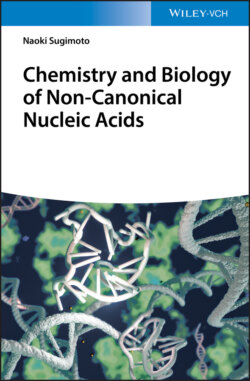Читать книгу Chemistry and Biology of Non-canonical Nucleic Acids - Naoki Sugimoto - Страница 21
2.2.1 Hoogsteen Base Pair
ОглавлениеHoogsteen base pair (Figure 2.1) is one of the major non-Watson–Crick base pairs that can be seen in several crystal structures of duplexes containing A·T base pairs. For example, the crystal structure of AT-rich sequences adopted parallel and antiparallel stranded duplexes with all Hoogsteen-type hydrogen bonding in their A·T base pairs (Figure 2.1) [3]. In the case of antiparallel duplex with the Hoogsteen base pairs, the overall structure features of the duplex such as diameter of the duplex, number of base pairs per turn, and sugar pucker conformation are similar to the canonical B-type DNA duplex. A unique characteristic is that the adenine nucleobases in the duplex have syn conformation in their glycosidic bond angles. Although the same pattern of hydrogen bonding is possible, A-type RNA duplexes disfavor the A·U Hoogsteen base pair because the A-form geometry disfavors the syn conformation in the adenine nucleobase due to sugar-backbone rearrangements needed to sterically accommodate the adenine [4]. Formation of Hoogsteen-type hydrogen bonding is also possible between guanine (G) and cytosine (C+), in which N3 atom is protonated. Formation of transient Hoogsteen base pairs including the G·C+ in diverse sequence composition has been demonstrated by relaxation dispersion assay using NMR (Figure 2.1) [5]. It is considered that the Hoogsteen base pairs play roles in modulating interaction of proteins and biological reactions such as induction or repair of DNA damage and replication of DNA by altering the structural and chemical properties of the duplex [5].
